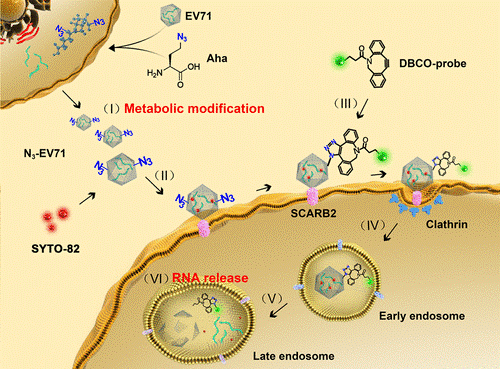
Researchers led by Prof. CAI Lintao from the Shenzhen Institutes of Advanced Technology (SIAT) of the Chinese Academy of Sciences proposed a novel virus labeling strategy based on protein biosynthesis for dynamic visualization of nonenveloped enterovirus 71 infection. The study was published in ACS Applied Materials & Interfaces.
Enterovirus 71 (EV71), a major cause of severe hand-foot-and-mouth disease (HFMD), can develop into serious and life-threatening neurological complications, such as brainstem encephalitis, meningitis, and poliomyelitis-like paralysis. Understanding the viral invasion pathway of EV71 is important for elucidating its pathogenesis.
Although genetic engineering and chemical coupling have been applied to track viral infection in host cells and in vivo, these strategies could potentially interfere with viral invasive pathways.
The newly proposed strategy could be used for precisely dissecting the invasive pathway of EV71, especially for clarifying the process of viral RNA uncoating.
The researchers found that L-azidohomoalanine (Aha), an azido derivative of methionine, was more effective than azido sugars in introducing azido motifs into viral capsid proteins by substituting methionine residues during viral protein biosynthesis and assembly.
"The azide-modified EV71 particles are then effectively labeled with dibenzocyclooctyl-functionalized fluorescence probes through an in situ bioorthogonal reaction with well-preserved viral infectivity," said Prof. CAI.
"The dual-labeled imaging clearly clarifies that EV71 virions primarily bind to scavenger receptors and are internalized through clathrin-mediated endocytosis. The viral particles are then transported into early and late endosomes where viral RNA is released in a low-pH dependent manner at about 70 min post infection," He added.
The research is an important milestone in the study of enterovirus infection. It clearly showed clathrin-mediated endocytosis and uncoating processes of EV71, especially the spatio-temporal dynamics of the virus infection in host cells.
These findings may play an important role in revealing the invasion route and pathogenesis of EV71 infection.
These results may shed light on the pathogenesis of EV71 infection and contribute to antiviral drug discovery, according to Prof. CAI.

Schematic illustration of bioorthogonal metabolic strategy based on protein biosynthesis for nonenveloped EV71 labeling and tracking (Image by PAN Hong)

86-10-68597521 (day)
86-10-68597289 (night)

52 Sanlihe Rd., Xicheng District,
Beijing, China (100864)

